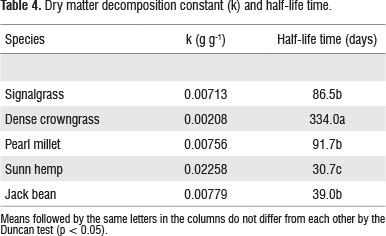Studies to select one or more species of coverage plants adapted to Amazonian soil and climate conditions of the Amazon are a promising strategy for the improvement of environmental quality, establishing no-till agricultural systems, and thereby reducing the impacts of monoculture farming. The aim of this study was to assess the persistence time, half-life time, macronutrient content and accumulation, and C:N ratio of straw coverage in a Ultisol in northeastern Pará. Experimental design was randomized blocks with five treatments and five replicates. Plants were harvested after 105 days, growth and biomass production was quantified. After 84 days, soil coverage was 97, 85, 52, 50, and 15% for signalgrass (Brachiaria brizantha) (syn. Urochloa), dense crowngrass (Panicum purpurascens), jack bean (Canavalia ensiformes), pearl millet (Pennisetum americanum) and sunn hemp (Crotalaria juncea,), respectively. Signalgrass yielded the greatest dry matter production (9,696 kg ha-1). It also had high C:N ratio (38.4), long half-life (86.5 days) and a high persistence in the field. Jack bean also showed high dry matter production (8,950 kg ha-1), but it had low C:N ratio (17.4) and lower half-life time (39 days) than the grasses. These attributes indicate that signalgrass and jack bean have a high potential for use as cover plants in no-till agricultural systems in the State of Pará.
Half-life; persistence of plant biomass; recycling nutrients; C / N ratio






